

The Equatorial Climate. Rain. Rainforest Climate. Earth Floor: Biomes. Tropical Rainforest The tropical rainforest is a hot, moist biome found near Earth's equator.
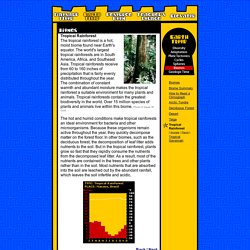
The world's largest tropical rainforests are in South America, Africa, and Southeast Asia. Tropical rainforests receive from 60 to 160 inches of precipitation that is fairly evenly distributed throughout the year. The combination of constant warmth and abundant moisture makes the tropical rainforest a suitable environment for many plants and animals. Tropical rainforests contain the greatest biodiversity in the world. Over 15 million species of plants and animals live within this biome. The hot and humid conditions make tropical rainforests an ideal environment for bacteria and other microorganisms. Average Percipitation. Fires-could-turn-amazon-rainforest-into-a-desert-as-human-activity-and-climate-change-threaten-lungs-of-the-world-says-study-9259741.
One of the last great wildernesses on earth – known as the lungs of the world – is balancing dangerously close to a “tipping point” where forest fires will become so commonplace and extensive that they will change much of the landscape forever, scientists said.
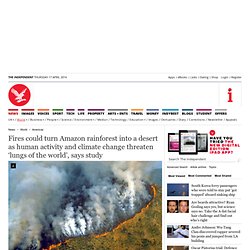
Although fires have always occurred in Amazonia, they have been largely controlled by the natural humidity of the region. Now, however, the drying out of the rainforest threatens to ignite the tree-filled habitat – with its rich biodiversity – and convert it almost overnight into barren desert, they warned. For the first time, scientists have shown in experiments on the ground how extreme, dry weather combined with the effects of human activities can create a tinderbox environment where intensely damaging forest fires can spread easily, killing trees that have taken hundreds of years to grow.
Earth Floor: Biomes. Rainforests Facts. Facts about Rainforests Do you know how many tropical rainforest plants have been identified as having anti-cancer properties?
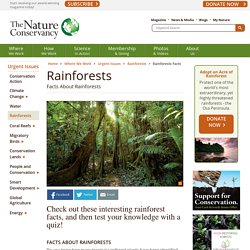
Or how many continents around the world contain rainforests? And just how quickly are the world's rainforests disappearing? Find out the answers to these questions and more as you check out these interesting rainforest facts! Tropical Rainforest. Plants. Leaves and whatnot. Rainforest Biomes. The tropical rain forest is a forest of tall trees in a region of year-round warmth.
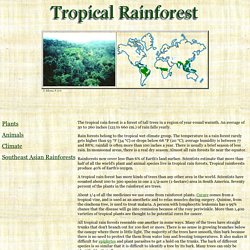
An average of 50 to 260 inches (125 to 660 cm.) of rain falls yearly. Rain forests belong to the tropical wet climate group. The temperature in a rain forest rarely gets higher than 93 °F (34 °C) or drops below 68 °F (20 °C); average humidity is between 77 and 88%; rainfall is often more than 100 inches a year. There is usually a brief season of less rain. In monsoonal areas, there is a real dry season.
Rainforests now cover less than 6% of Earth's land surface. A tropical rain forest has more kinds of trees than any other area in the world. Flower. Tropical Rainforest Plants. Animals. Plants in the Rainforest. Frog. TROPICAL RAIN FOREST ANIMALS. Rainforest Animals. Really Wild Animals: Totally Tropical Rainforest. Toucan. Top 5 Ways Wildfires Start" Plenty of natural phenomena can turn the landscape into a blazing inferno and send wildlife racing for safety.

Lightning, volcanoes, dragons -- all are devastating forces of fiery destruction that can start a conflagration in seconds. But despite how destructive it sounds, fire isn't always bad for a forest. In some ways it destroys, but it can also revitalize, clearing away cluttered brush and leaving fertilized soil and fresh growing space in its wake. In fact, some ecosystems depend on a regular fire regime to spur processes such as reproduction and germination. Humans have long recognized the rejuvenating power of fire. But while fire can be fundamental for promoting healthy forest growth, sometimes too much of it is a bad thing -- especially when a blaze swells out of control and threatens homes and other important infrastructure.
Reptiles. Endanger Species In The Rainforest. The Philippine Tarsier Is Listed As A Near-Threatened Species.

Tropical Rainforest. Where are tropical rainforests found?
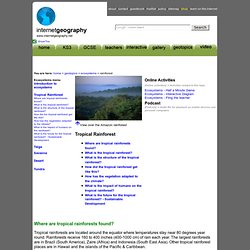
Tropical rainforests are located around the equator where temperatures stay near 80 degrees year round. Rainforests receive 160 to 400 inches (400-1000 cm) of rain each year. The largest rainforests are in Brazil (South America), Zaire (Africa) and Indonesia (South East Asia). Rainforest Importance. Current State of tropical rainforests. Rainforests have always been subject to destructive natural forces -storms, landslides, floods, mud flows, volcanic eruptions, high winds, fire (mainly from lightning), drought, and climate change.

These factors have recently been overwhelmed by anthropogenic (human) forces, however, as rainforests are being cut down everywhere at a very high rate. Rain Forest Threats, Rain Forest Species. More than half of Earth’s rain forests have already been lost forever to the insatiable human demand for wood and arable land.

Rain forests that once grew over 14 percent of the land on Earth now cover only about 6 percent. And if current deforestation rates continue, these critical habitats could disappear from the planet completely within the next hundred years. The reasons for plundering rain forests are mainly economic. Wealthy nations drive demand for tropical timber, and cash-strapped governments often grant logging concessions at a fraction of the land’s true value. “Homesteader” policies also encourage citizens to clear-cut forests for farms.
Wildlife Trade. Our work Display of illegal wildlife products used in Chinese medicine confiscated by customs officers at Heathrow Airport, UK. © WWF-Canon/Edward PARKERWildlife trade is any sale or exchange of wild animal and plant resources by people.
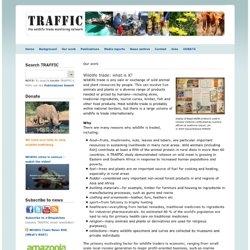
This can involve live animals and plants or a diverse range of products needed or prized by humans—including skins, medicinal ingredients, tourist curios, timber, fish and other food products. Cutting rainforests for farm lands. CBBC Newsround: Amazon deforestation. Some main reasons why areas of rainforests are cut down:Farming e.g. soya fields, cattle ranches Mining Flooding areas of land as part of hydro electric power stations Logging to sell the timber Once the trees go, the soil becomes infertile in one or two years, making it poor for farming.
Hunting becomes more difficult for the people who live there as the habitat for wildlife is lost. Traditional people's cultures are also lost. The effects of deforestation: Trees are removed. Trees do not protect soil so nutrients are washed out by the rain. Soil is now less fertile and the unprotected surface becomes dry and compacted. Rainforest food chain: top predators. The Tiger Sits At The Center Of The Rainforest Food Web. Photo:Mila Zinkova The relationships among species in an ecosystem have often been described as a “food chain” in which the larger animals eat the smaller. But the food-chain image is a two-dimension one, when in fact the picture is much more complex. Rain forest relationships are better described as a web—a rainforest food web. In this complex rain forest web of life, the insects of the rainforest floor tend to eat plants, fungi, decaying material and other insects, and in turn be eaten by spiders, among a host of other creatures. Live Science: Deforestation.
Deforestation is the permanent destruction of forests in order to make the land available for other uses. An estimated 18 million acres (7.3 million hectares) of forest, which is roughly the size of the country of Panama, are lost each year, according to the United Nations' Food and Agriculture Organization (FAO). Some other statistics: About half of the world's tropical forests have been cleared (FAO) Forests currently cover about 30 percent of the world’s land mass (National Geographic) Forest loss contributes between 6 percent and 12 percent of annual global carbon dioxide emissions (Nature Geoscience) About 36 football fields worth of trees lost every minute (World Wildlife Fund (WWF)) Deforestation occurs around the world, though tropical rainforests are particularly targeted.
NASA predicts that if current deforestation levels proceed, the world's rainforests may be completely in as little as 100 years. Error loading player: No playable sources found Weather vs. BBC Nature - Rainforest videos, news and facts. What is a Rainforest? Rainforest Information for Kids. Help with Rainforest School Reports. Rain Forest Report Card. Deforestation of Tropical Rain Forests Throughout the tropics, rain forests are being cut down.
By different methods and for different reasons, people in tropical regions of the world are cutting down, burning, or otherwise damaging the forests. The process in which a forest is cut down, burned or damaged is called "deforestation. " Global alarm has risen because of the destruction of tropical rain forests. Not only are we losing beautiful areas, but the losses strike deeper. How Deforestation Happens Deforestation occurs in many ways. Facts on the Rainforest. Rainforest Climate. Current State of Tropical Rainforests. The CAUSES of RAINFOREST DESTRUCTION. Return to Education Supplement ContentsRainforest Information Centre Educational Supplement The CAUSES of RAINFOREST DESTRUCTION The following issues are discussed: 1.
Immediate Causes Logging Agriculture-Shifted Cultivators Agricultures-Cash Crops & Cattle Ranching Fuelwood Large Dams Mining and Industry Colonisation Schemes Tourism 2. Environmental Facts. Rainforest Facts. The Disappearing Rainforests. Rainforest Importance. Fun facts. Info_8116227_10-interesting-tropical-rainforest-biome. At least 80% of the developed world's diet originated in the tropical rainforest. Its gifts to the world include fruits like avocados, coconuts, figs, oranges, lemons, grapefruit, bananas, guavas, pineapples, mangoes and tomatoes. It has also provided vegetables including corn, potatoes, winter squash and yams; spices like black pepper, cayenne, chocolate, cinnamon, cloves, ginger, sugar cane, tumeric, coffee and vanilla and nuts including Brazil nuts and cashews. Amazon Rainforest Facts for Kids. Fun Rainforest Facts for Kids - Interesting Facts about Tropical & Temperate Rainforests. Fun Rainforest Facts for Kids - Interesting Facts about Tropical & Temperate Rainforests.
Tree frog. Green tree snake. Trees. Baby gorilla. Toucan. Red panda. Rivers. Flowers. Flowering plant. Sun filters through canopy. Misty, low lying moisture(fog) Ferns. Tropical Rainforest Plants.